Version 2.00 15-Sep-2005
MIPI Alliance Standard for Display Pixel Interface
MIPI Alliance Standard for Display Pixel Interface
(DPI-2)
Version 2.00 – 15 September 2005
MIPI Board Approved 23-Jan-2006
Copyright © 2005-2006 MIPI Alliance, Inc. All rights reserved.
MIPI Alliance Member Confidential.
i
�
Version 2.00 15-Sep-2005
MIPI Alliance Standard for Display Pixel Interface
NOTICE OF DISCLAIMER
The material contained herein is not a license, either expressly or impliedly, to any IPR owned or controlled
by any of the authors or developers of this material or MIPI. The material contained herein is provided on
an “AS IS” basis and to the maximum extent permitted by applicable law, this material is provided AS IS
AND WITH ALL FAULTS, and the authors and developers of this material and MIPI hereby disclaim all
other warranties and conditions, either express, implied or statutory, including, but not limited to, any (if
any) implied warranties, duties or conditions of merchantability, of fitness for a particular purpose, of
accuracy or completeness of responses, of results, of workmanlike effort, of lack of viruses, and of lack of
negligence.
ALSO, THERE IS NO WARRANTY OF CONDITION OF TITLE, QUIET ENJOYMENT, QUIET
POSSESSION, CORRESPONDENCE TO DESCRIPTION OR NON-INFRINGEMENT WITH REGARD
TO THIS MATERIAL OR THE CONTENTS OF THIS DOCUMENT. IN NO EVENT WILL ANY
AUTHOR OR DEVELOPER OF THIS MATERIAL OR THE CONTENTS OF THIS DOCUMENT OR
MIPI BE LIABLE TO ANY OTHER PARTY FOR THE COST OF PROCURING SUBSTITUTE
GOODS OR SERVICES, LOST PROFITS, LOSS OF USE, LOSS OF DATA, OR ANY INCIDENTAL,
CONSEQUENTIAL, DIRECT, INDIRECT, OR SPECIAL DAMAGES WHETHER UNDER
CONTRACT, TORT, WARRANTY, OR OTHERWISE, ARISING IN ANY WAY OUT OF THIS OR
ANY OTHER AGREEMENT, SPECIFICATION OR DOCUMENT RELATING TO THIS MATERIAL,
WHETHER OR NOT SUCH PARTY HAD ADVANCE NOTICE OF THE POSSIBILITY OF SUCH
DAMAGES.
Without limiting the generality of this Disclaimer stated above, the user of the contents of this Document is
further notified that MIPI: (a) does not evaluate, test or verify the accuracy, soundness or credibility of the
contents of this Document; (b) does not monitor or enforce compliance with the contents of this Document;
and (c) does not certify, test, or in any manner investigate products or services or any claims of compliance
with the contents of this Document. The use or implementation of the contents of this Document may
involve or require the use of intellectual property rights ("IPR") including (but not limited to) patents,
patent applications, or copyrights owned by one or more parties, whether or not Members of MIPI. MIPI
does not make any search or investigation for IPR, nor does MIPI require or request the disclosure of any
IPR or claims of IPR as respects the contents of this Document or otherwise.
Questions pertaining to this document, or the terms or conditions of its provision, should be addressed to:
MIPI Alliance, Inc.
c/o IEEE-ISTO
445 Hoes Lane
Piscataway, NJ 08854
Attn: Board Secretary
1
2
3
4
5
6
7
8
9
10
11
12
13
14
15
16
17
18
19
20
21
22
23
24
25
26
27
28
29
30
31
32
33
34
35
Copyright © 2005-2006 MIPI Alliance, Inc. All rights reserved.
MIPI Alliance Member Confidential.
ii
�
Version 2.00 15-Sep-2005
MIPI Alliance Standard for Display Pixel Interface
1.1
1.2
2.1
2.2
2.3
Contents
Version 2.00 – 15 September 2005 ..................................................................................................................i
1 Overview .................................................................................................................................................4
Scope ...............................................................................................................................................4
Purpose ............................................................................................................................................4
2 Terminology ............................................................................................................................................5
Definitions .......................................................................................................................................5
Abbreviations ..................................................................................................................................5
Acronyms ........................................................................................................................................6
3 References ...............................................................................................................................................7
4 Display Architectures and Interface Constructions .................................................................................8
Display Architectures ......................................................................................................................8
5 Display Pixel Interface Interoperability.................................................................................................13
Interface Signal Description ..................................................................................................................15
6
Power Supply Connections............................................................................................................15
Interface Signals ............................................................................................................................15
Programmable Timing Parameters ........................................................................................................16
Interface Color Coding ..........................................................................................................................18
Interface Electrical Characteristics........................................................................................................20
Electrical Characteristics ...............................................................................................................20
DPI Timing Parameter Examples ......................................................................................................23
Type 2 and Type 3 Display Architecture Control Interfaces.............................................................30
Type 4 Architecture Shutdown and Color Mode Signals ..................................................................31
12.1 Shutdown for Type 4 Architecture ................................................................................................31
12.2 Color Mode for Type 4 Architecture.............................................................................................33
Command Set ....................................................................................................................................34
6.1
6.2
7
8
9
10
11
12
13
4.1
9.1
36
37
38
39
40
41
42
43
44
45
46
47
48
49
50
51
52
53
54
55
56
57
58
59
60
61
Copyright © 2005-2006 MIPI Alliance, Inc. All rights reserved.
MIPI Alliance Member Confidential.
iii
�
Version 2.00 15-Sep-2005
MIPI Alliance Standard for Display Pixel Interface
MIPI Alliance Standard for Display Pixel Interface
1 Overview
This document describes Display Pixel Interface (DPI), which is used for Active-Matrix LCD displays for
handheld devices. The interface may be configured with data path of 16, 18 or 24 parallel data bits, and
several control signals.
This document specifies the interface requirements for both ends (host and display) of the link, including
the following attributes:
• Electrical
• Timing
• Pixel formats (mapping of pixel bits to data signals)
• Command set to control display behaviors
1.1 Scope
The scope of this document is to specify an electrical and logical interface between a host system
(processor or controller) and an active-matrix (AM) display module. The specification is intended for
display modules in mobile devices, with display resolution up to 800x480 pixels. This specification does
not apply to passive-matrix display modules.
Included, and within the scope of this specification, is the power supply for interface signaling between the
host processor and the display module. However, power supply for other functions in the display module
are beyond the scope of this specification.
1.2 Purpose
The Display Pixel Interface specification is used by manufacturers to design products that adhere to MIPI
specifications for mobile device processor, camera and display interfaces.
Implementing the DPI standard reduces the time-to-market and design cost of mobile devices by
simplifying the interconnection of products from different manufacturers. In addition, adding new features
such as larger or additional displays to mobile devices is simplified due to the extensible nature of the MIPI
specifications.
62
63
64
65
66
67
68
69
70
71
72
73
74
75
76
77
78
79
80
81
82
83
84
85
86
87
Copyright © 2005-2006 MIPI Alliance, Inc. All rights reserved.
MIPI Alliance Member Confidential.
4
�
Version 2.00 15-Sep-2005
MIPI Alliance Standard for Display Pixel Interface
2 Terminology
2.1 Definitions
Command: Digital information used to control display behavior and to identify the connected display
module
Data: Digital image data stored in the frame memory or numerical information to define the display
module behavior accompanied with a command
Display Controller: Isolated IC silicon chip or integrated functional block in the host processor to control
a display module; may or may not include frame memory
Display Device: Functional device which can show image, such as Liquid Crystal Displays
Display Driver IC: IC silicon chip in a display module used to control the display device; may or may not
include frame memory
Display Glass: Same as display device, coming from material name
Display Module: Functional module to show image on it, can consists of display device, display driver IC,
other peripheral components and circuits and display interface
Display Panel: Same as Display Device, coming from the physical outward appearance of the display
device
Frame Memory: Memory device integrated in a display driver IC or display controller in order to provide
image data for refreshing the display device. Full-frame memory provides a full screen area of image data
while partial-frame memory only provides memory for a portion of the screen area.
Type 1 Display Architecture: One of the defined display module architectures. In DSI, DBI, DPI, and
DCS, a display module architecture in which a display module includes a display device, display driver IC,
full-frame memory, registers, timing controller, non-volatile memory and control interface.
Type 2 Display Architecture: One of the defined display module architectures. In DSI, DBI, DPI, and
DCS, a display module architecture in which a display module includes a display device, display driver IC,
partial-frame memory, registers, timing controller, non-volatile memory, control interface and video stream
interface.
Type 3 Display Architecture: One of the defined display module architectures. In DSI, DBI, DPI, and
DCS, a display module architecture in which a display module includes a display device, display driver IC,
registers, timing controller, non-volatile memory, control interface and video stream interface.
Type 4 Display Architecture: One of the defined display module architectures. In DSI, DBI, DPI, and
DCS, a display module architecture in which a display module includes a display device, display driver IC,
registers, timing controller, control lines and video stream interface.
2.2 Abbreviations
High-Z High Impedance
H-Sync Horizontal Synchronization
88
89
90
91
92
93
94
95
96
97
98
99
100
101
102
103
104
105
106
107
108
109
110
111
112
113
114
115
116
117
118
119
120
121
122
Copyright © 2005-2006 MIPI Alliance, Inc. All rights reserved.
MIPI Alliance Member Confidential.
5
�
Version 2.00 15-Sep-2005
MIPI Alliance Standard for Display Pixel Interface
123
124
125
126
127
128
129
130
131
132
133
134
135
136
137
138
139
140
141
142
143
144
145
146
147
148
Ta
Ambient Temperature
VDD
Power Supply
VDDI
Logic Level Supply
V-Sync Vertical Synchronization
2.3 Acronyms
AGND Analog ground, for power connection
AM
Active Matrix
ASIC Application Specific Integrated Circuit
CM
Color Mode
CMOS Complementary Metal Oxide Semiconductor
DBI
Display Bus Interface
DCS Display Command Set
DE
Data Enable
DGND Logic ground, for power connection
DOI
Dependent On Implementation
HBP Horizontal Back Porch
HFP
Horizontal Front Porch
I/O
Input/Output
LCD
Liquid Crystal Display
LSB
Least Significant Bit
MIPI Mobile Industry Processor Interface
MSB Most Significant Bit
PCLK Pixel Clock
SD
Shutdown
VBP Vertical Back Porch
VFP
Vertical Front Porch
Copyright © 2005-2006 MIPI Alliance, Inc. All rights reserved.
MIPI Alliance Member Confidential.
6
�
Version 2.00 15-Sep-2005
MIPI Alliance Standard for Display Pixel Interface
149
150
151
3 References
[1]
[2]
MIPI Alliance Standard for Display Command Set, version 0.36, June 2005
MIPI Alliance Standard for Display Bus Interface, version 0.xx, August 2005
Copyright © 2005-2006 MIPI Alliance, Inc. All rights reserved.
MIPI Alliance Member Confidential.
7
�
Version 2.00 15-Sep-2005
MIPI Alliance Standard for Display Pixel Interface
152
153
154
155
156
157
158
159
160
161
162
163
164
165
166
167
168
169
170
4 Display Architectures and Interface Constructions
4.1 Display Architectures
The display module shall be based on Type 1, Type 2, Type 3 or Type 4 display architecture.
The Type 1 Display Architecture should consist of the following functional blocks:
Display Device. Used to show the image data.
Display Driver. May be one or more devices used to drive the display device.
Full-frame memory. Used to hold the image data; can be integrated in the display driver.
Registers. Used to configure the display module behavior and hold identification information; can
be integrated in the display driver.
Timing Controller. Provides timing signals to control the display device and display driver based
on configuration information; can be integrated in the display driver.
Non-volatile memory. Used to store default register and configuration values; can be integrated in
the display driver.
Control Interface. Provides the interface between the host processor and the display driver; can be
integrated in the display driver.
Display Driving Circuit. As a part of display driver, used to convert timing signals and voltages to
signals appropriate to drive the display device.
Power Supply. Used to convert system voltages to levels usable by the display device and display
driver; can be integrated in the display driver.
Copyright © 2005-2006 MIPI Alliance, Inc. All rights reserved.
MIPI Alliance Member Confidential.
8
�
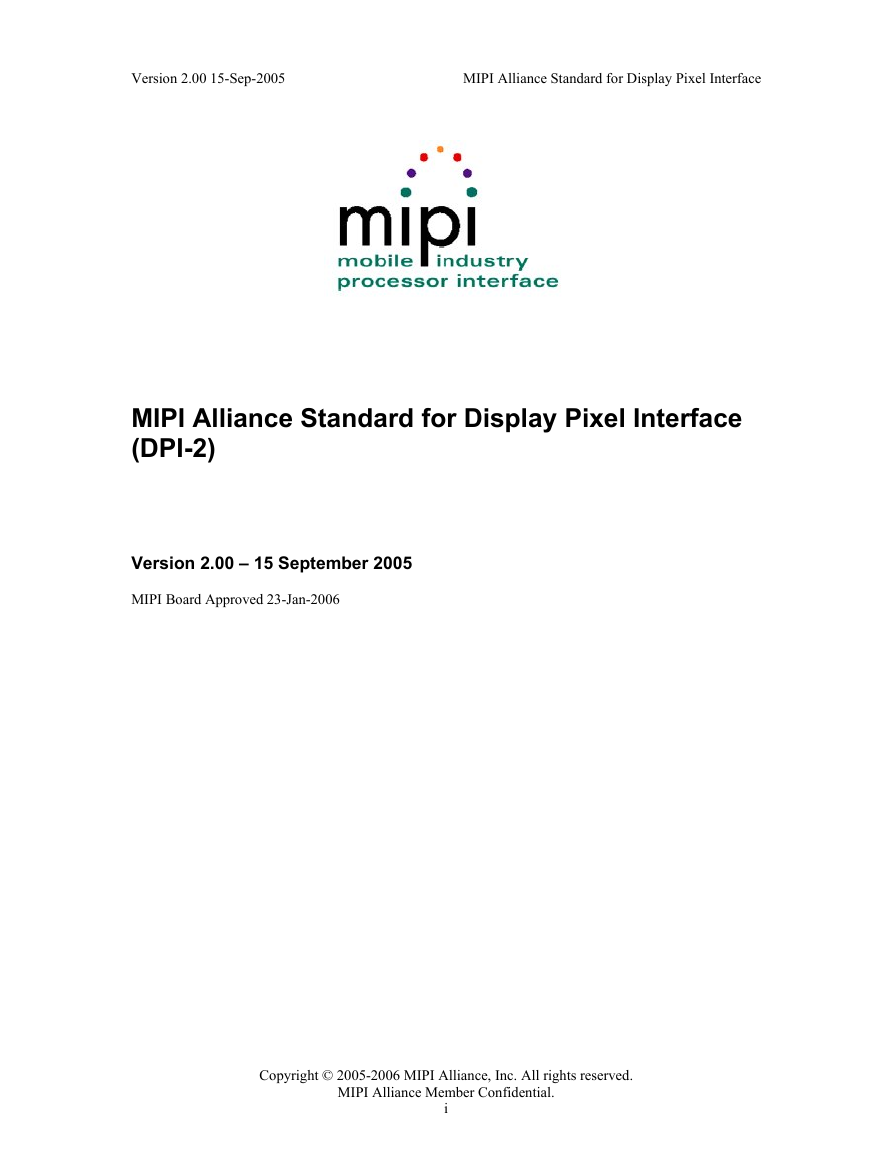
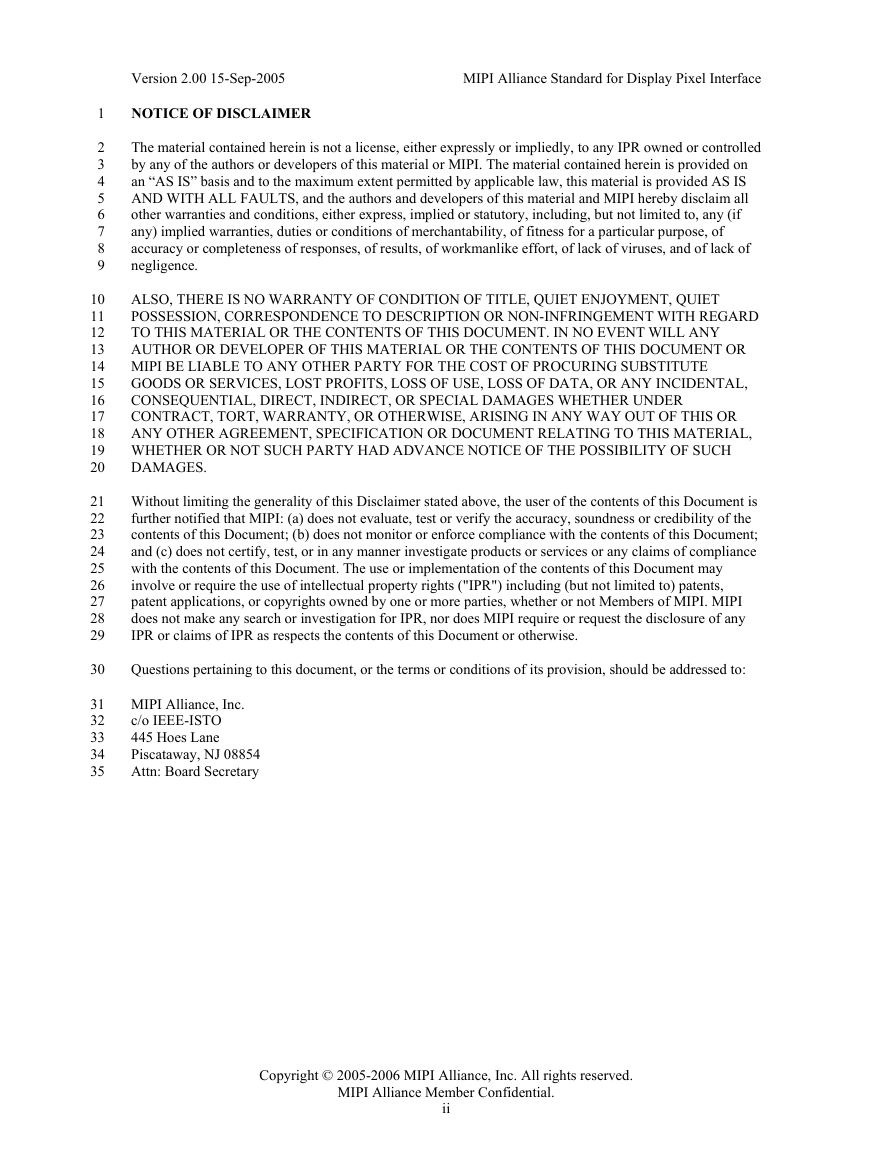
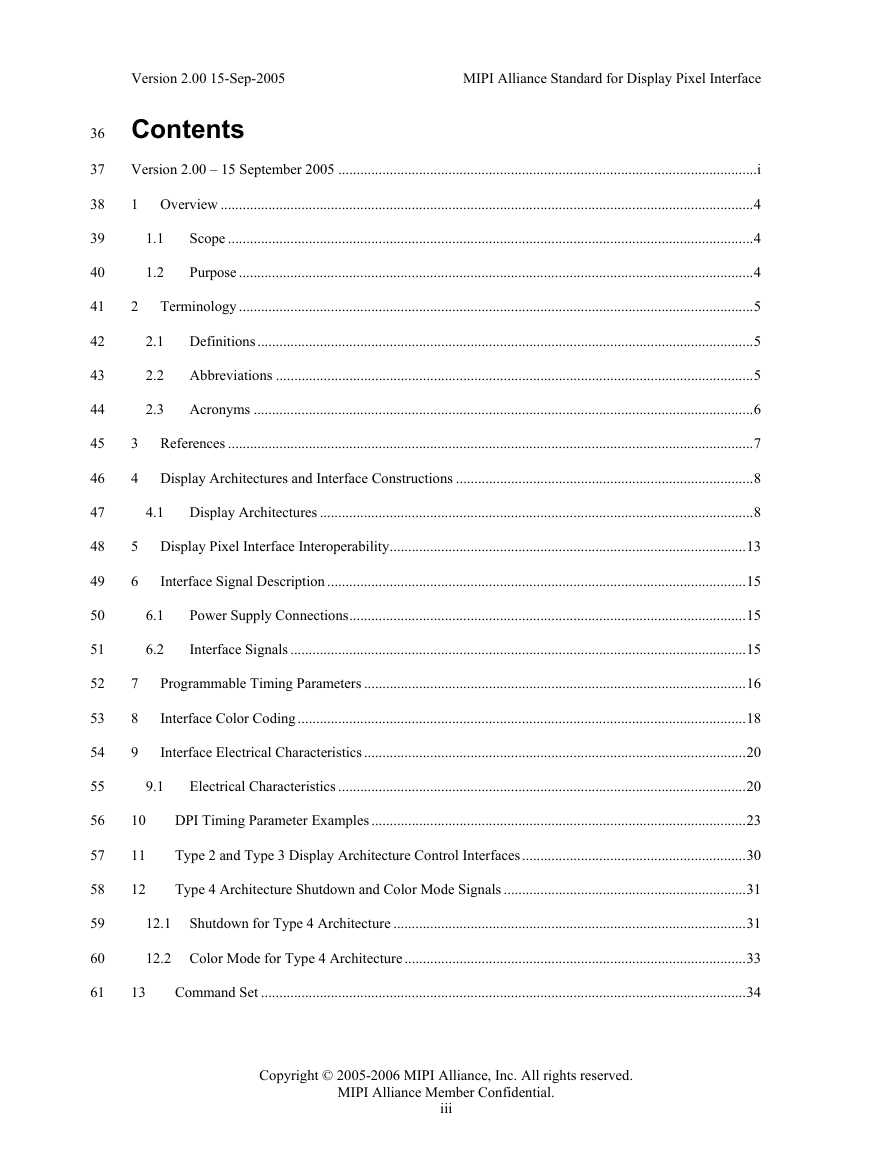
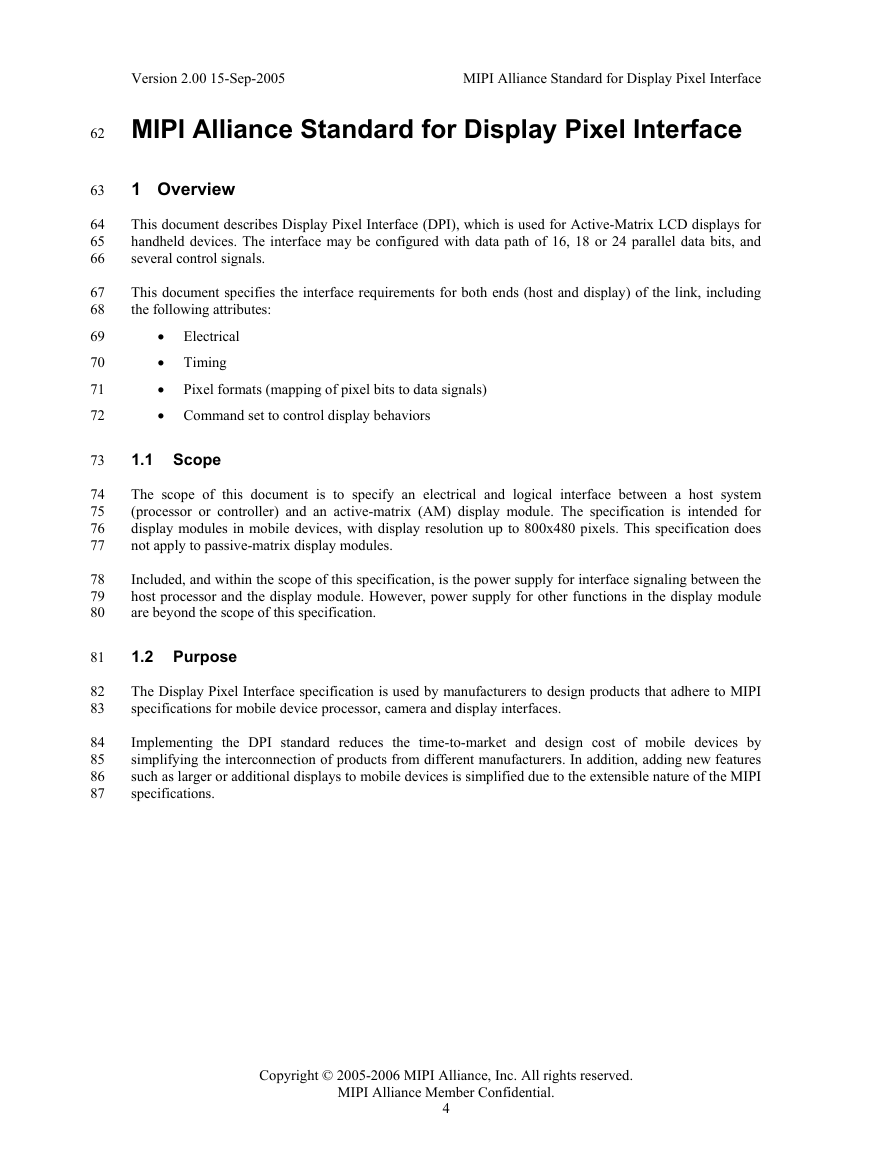
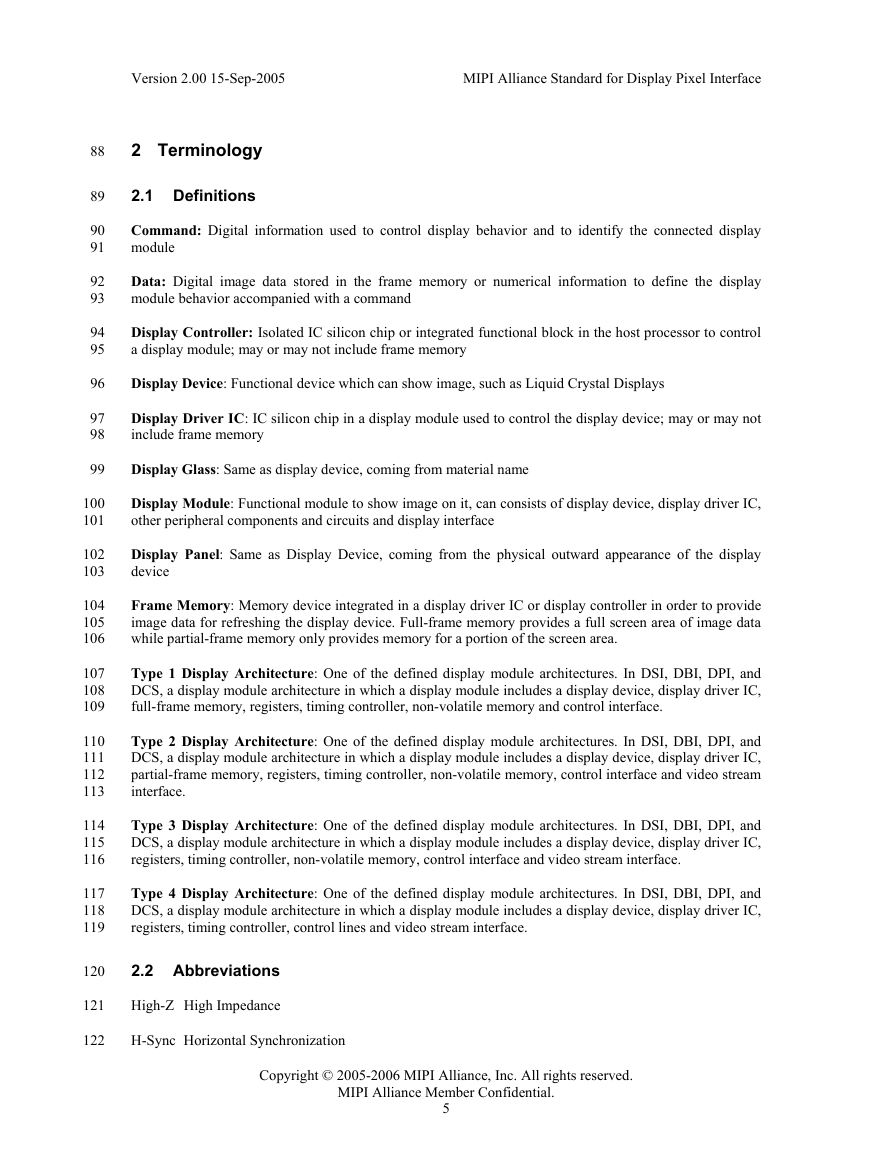
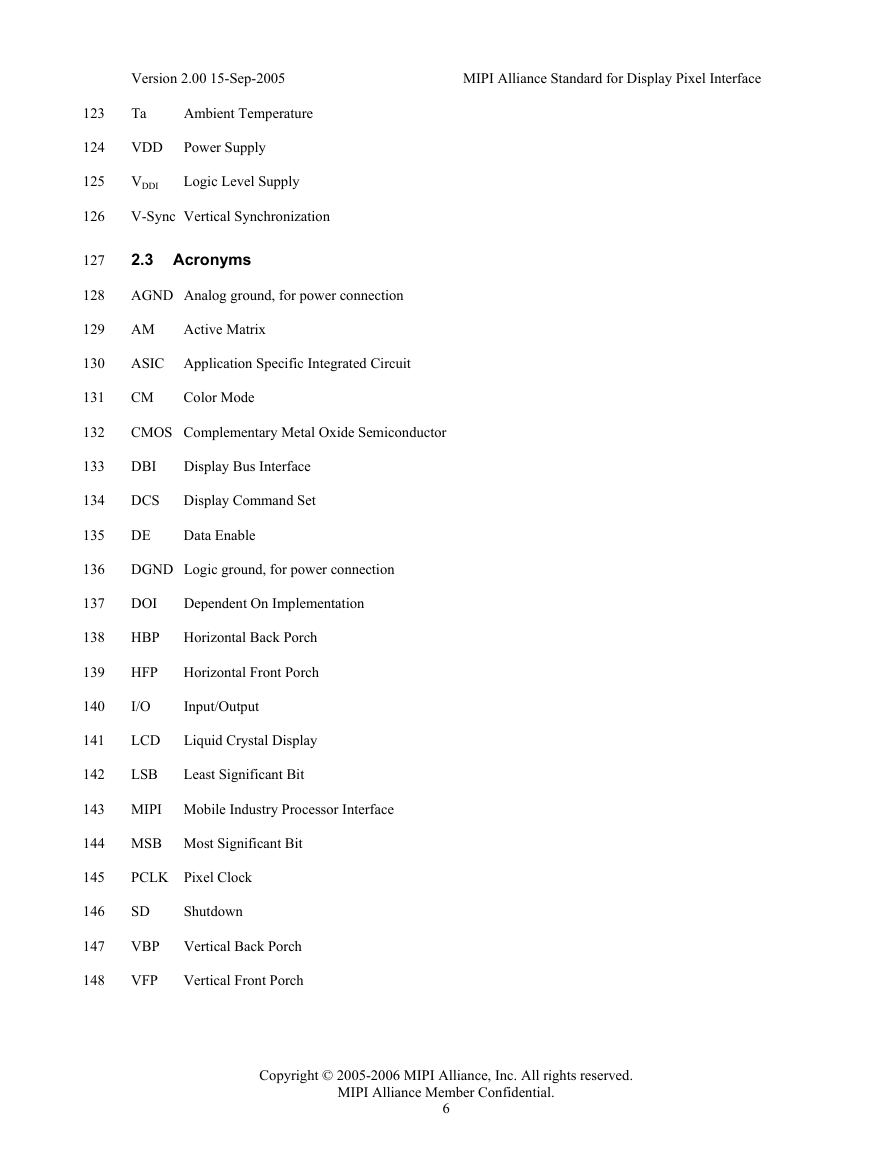
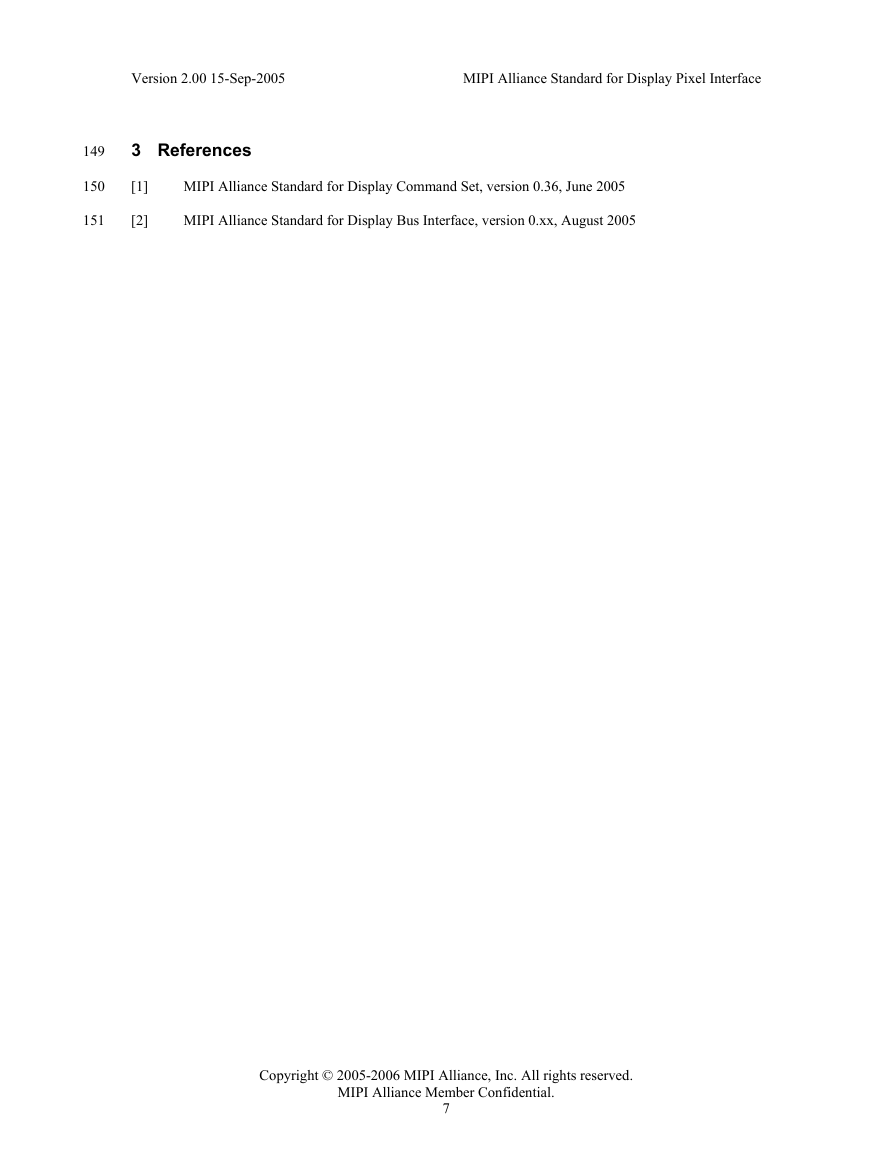
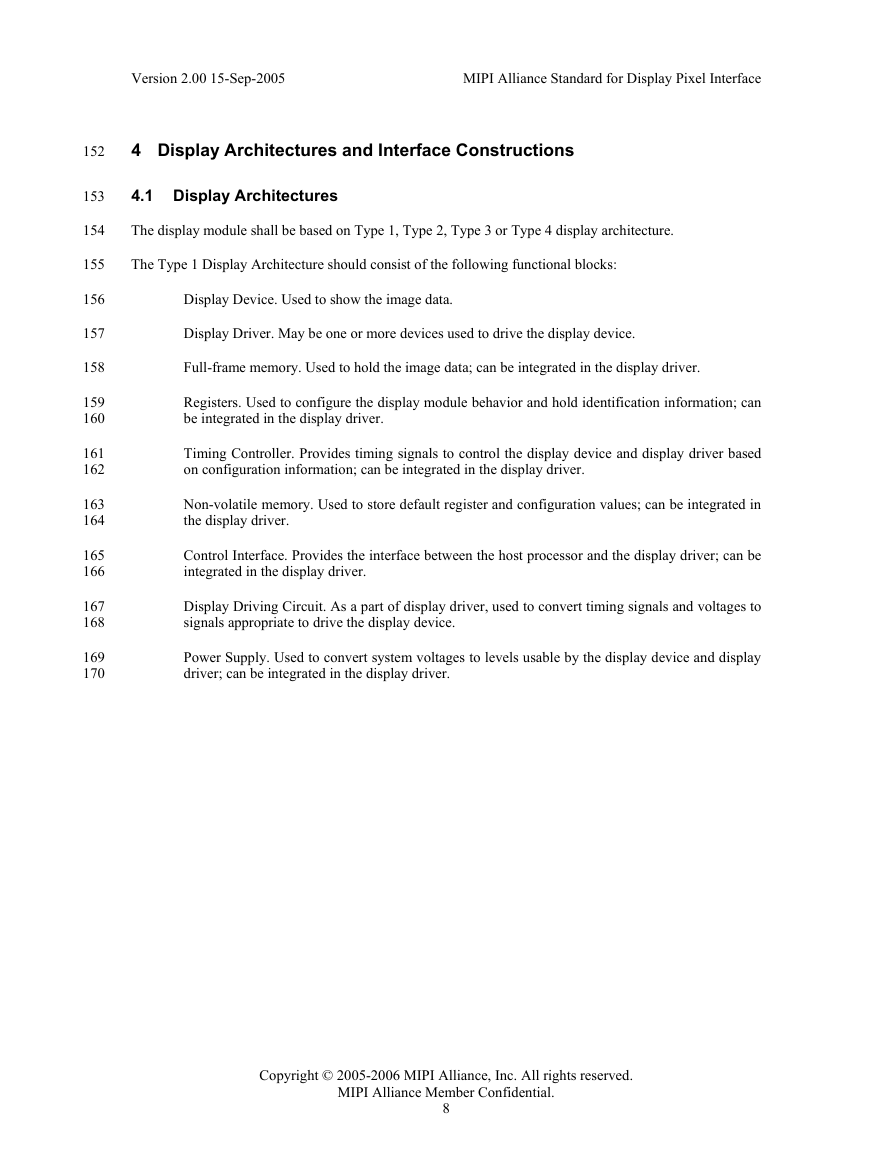








 2023年江西萍乡中考道德与法治真题及答案.doc
2023年江西萍乡中考道德与法治真题及答案.doc 2012年重庆南川中考生物真题及答案.doc
2012年重庆南川中考生物真题及答案.doc 2013年江西师范大学地理学综合及文艺理论基础考研真题.doc
2013年江西师范大学地理学综合及文艺理论基础考研真题.doc 2020年四川甘孜小升初语文真题及答案I卷.doc
2020年四川甘孜小升初语文真题及答案I卷.doc 2020年注册岩土工程师专业基础考试真题及答案.doc
2020年注册岩土工程师专业基础考试真题及答案.doc 2023-2024学年福建省厦门市九年级上学期数学月考试题及答案.doc
2023-2024学年福建省厦门市九年级上学期数学月考试题及答案.doc 2021-2022学年辽宁省沈阳市大东区九年级上学期语文期末试题及答案.doc
2021-2022学年辽宁省沈阳市大东区九年级上学期语文期末试题及答案.doc 2022-2023学年北京东城区初三第一学期物理期末试卷及答案.doc
2022-2023学年北京东城区初三第一学期物理期末试卷及答案.doc 2018上半年江西教师资格初中地理学科知识与教学能力真题及答案.doc
2018上半年江西教师资格初中地理学科知识与教学能力真题及答案.doc 2012年河北国家公务员申论考试真题及答案-省级.doc
2012年河北国家公务员申论考试真题及答案-省级.doc 2020-2021学年江苏省扬州市江都区邵樊片九年级上学期数学第一次质量检测试题及答案.doc
2020-2021学年江苏省扬州市江都区邵樊片九年级上学期数学第一次质量检测试题及答案.doc 2022下半年黑龙江教师资格证中学综合素质真题及答案.doc
2022下半年黑龙江教师资格证中学综合素质真题及答案.doc